BUSN20016 - Analyzing Net Banking Frauds and Prevention in Australia
VerifiedAdded on 2023/06/14
|6
|962
|459
Report
AI Summary
This report investigates net banking frauds and scams in Australia, focusing on their effects and prevention strategies. It identifies various types of online fraud, including mobile banking, shimming, phishing, and mule recruitment, highlighting the significant financial losses suffered by Australians. The study aims to identify loopholes that contribute to the rise in online fraud and suggests ways to prevent them, while also assessing the effectiveness of refund arrangements. Through literature reviews, data series, and surveys employing both quantitative and qualitative approaches, the research seeks to analyze the impact of online banking fraud on the economy and society, recommend fraud minimization strategies, and enhance online banking trust and security. The report also includes references to support its findings and methodologies.
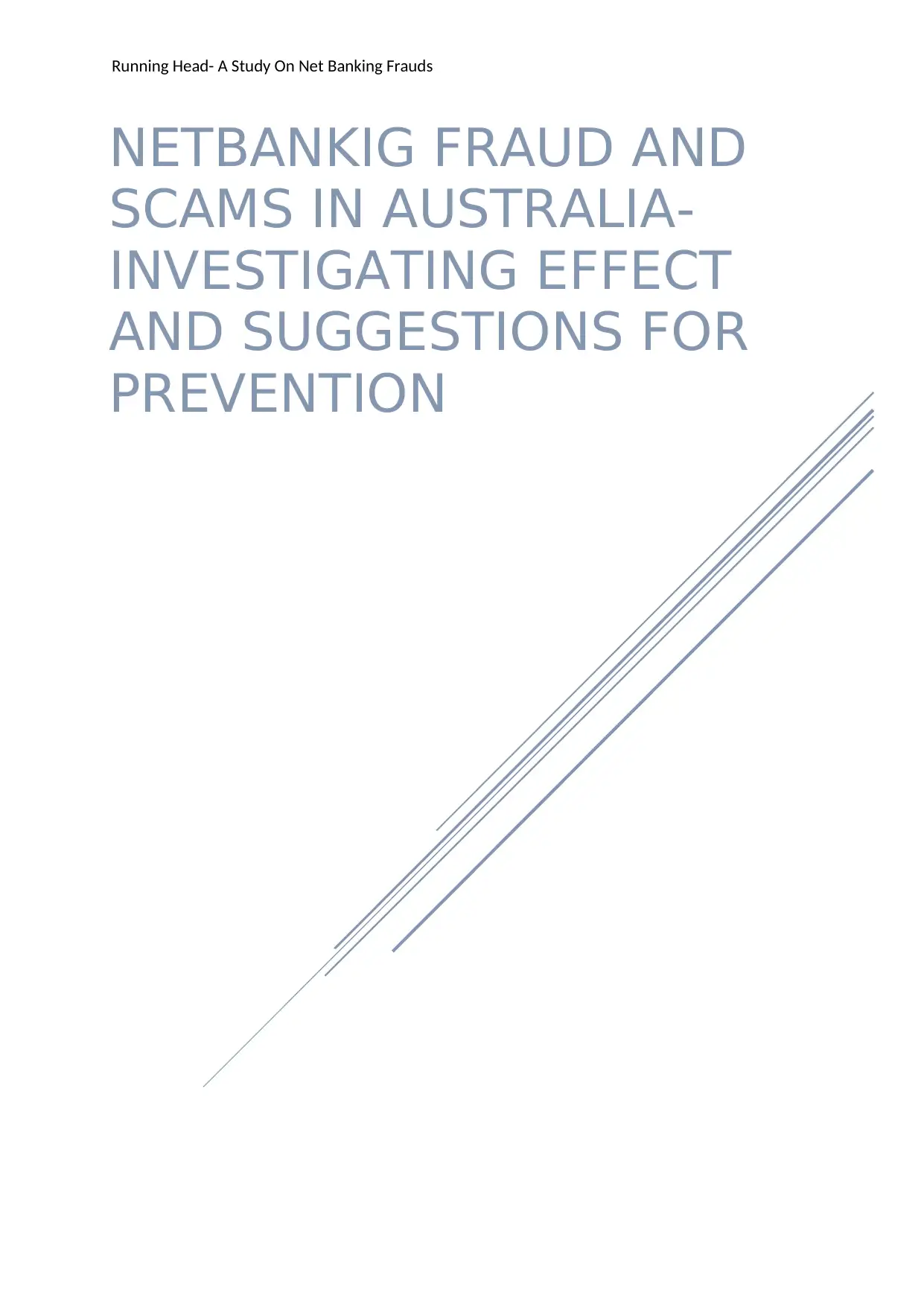
Running Head- A Study On Net Banking Frauds
NETBANKIG FRAUD AND
SCAMS IN AUSTRALIA-
INVESTIGATING EFFECT
AND SUGGESTIONS FOR
PREVENTION
NETBANKIG FRAUD AND
SCAMS IN AUSTRALIA-
INVESTIGATING EFFECT
AND SUGGESTIONS FOR
PREVENTION
Paraphrase This Document
Need a fresh take? Get an instant paraphrase of this document with our AI Paraphraser
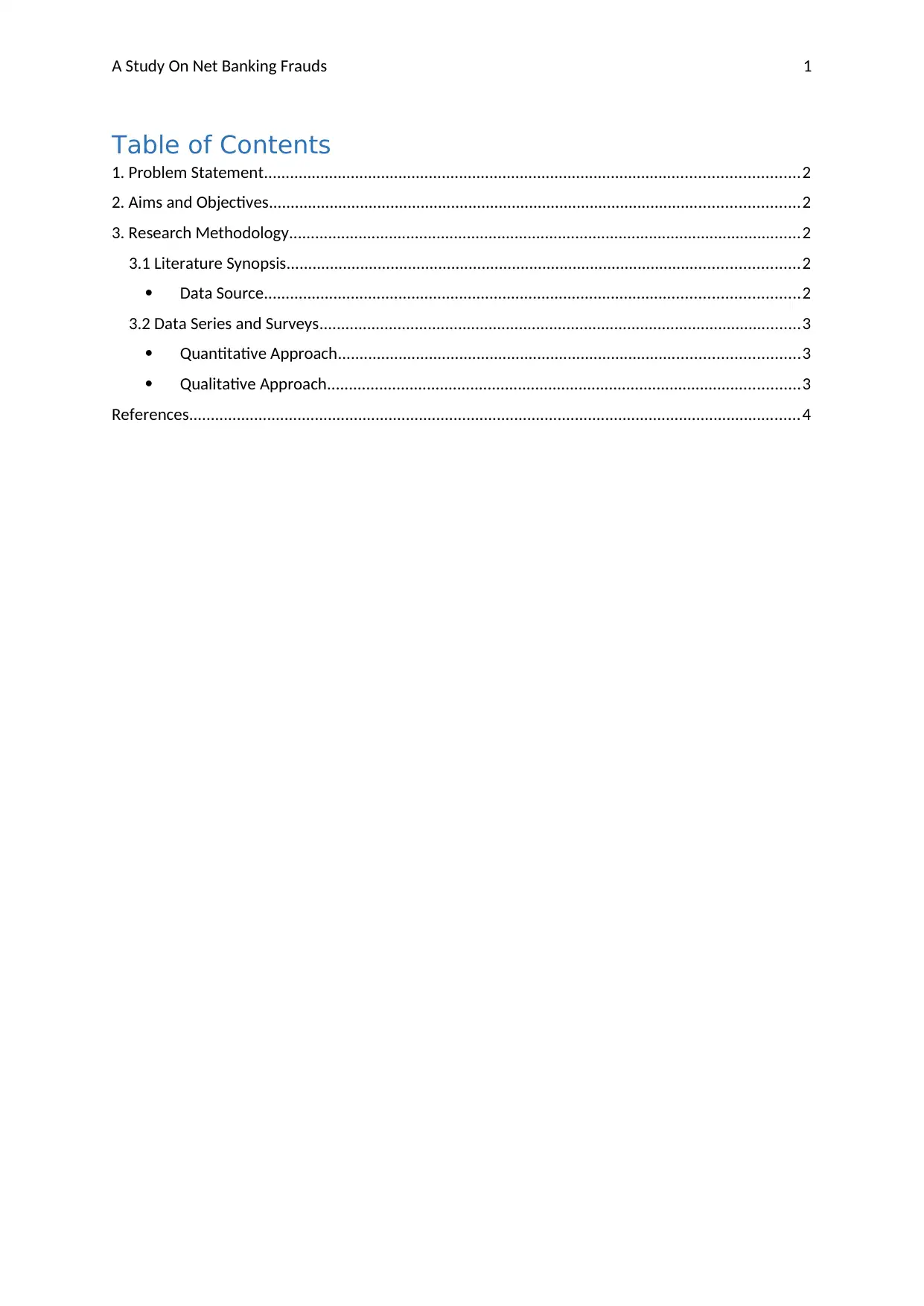
A Study On Net Banking Frauds 1
Table of Contents
1. Problem Statement...........................................................................................................................2
2. Aims and Objectives..........................................................................................................................2
3. Research Methodology......................................................................................................................2
3.1 Literature Synopsis......................................................................................................................2
Data Source...........................................................................................................................2
3.2 Data Series and Surveys...............................................................................................................3
Quantitative Approach..........................................................................................................3
Qualitative Approach.............................................................................................................3
References.............................................................................................................................................4
Table of Contents
1. Problem Statement...........................................................................................................................2
2. Aims and Objectives..........................................................................................................................2
3. Research Methodology......................................................................................................................2
3.1 Literature Synopsis......................................................................................................................2
Data Source...........................................................................................................................2
3.2 Data Series and Surveys...............................................................................................................3
Quantitative Approach..........................................................................................................3
Qualitative Approach.............................................................................................................3
References.............................................................................................................................................4
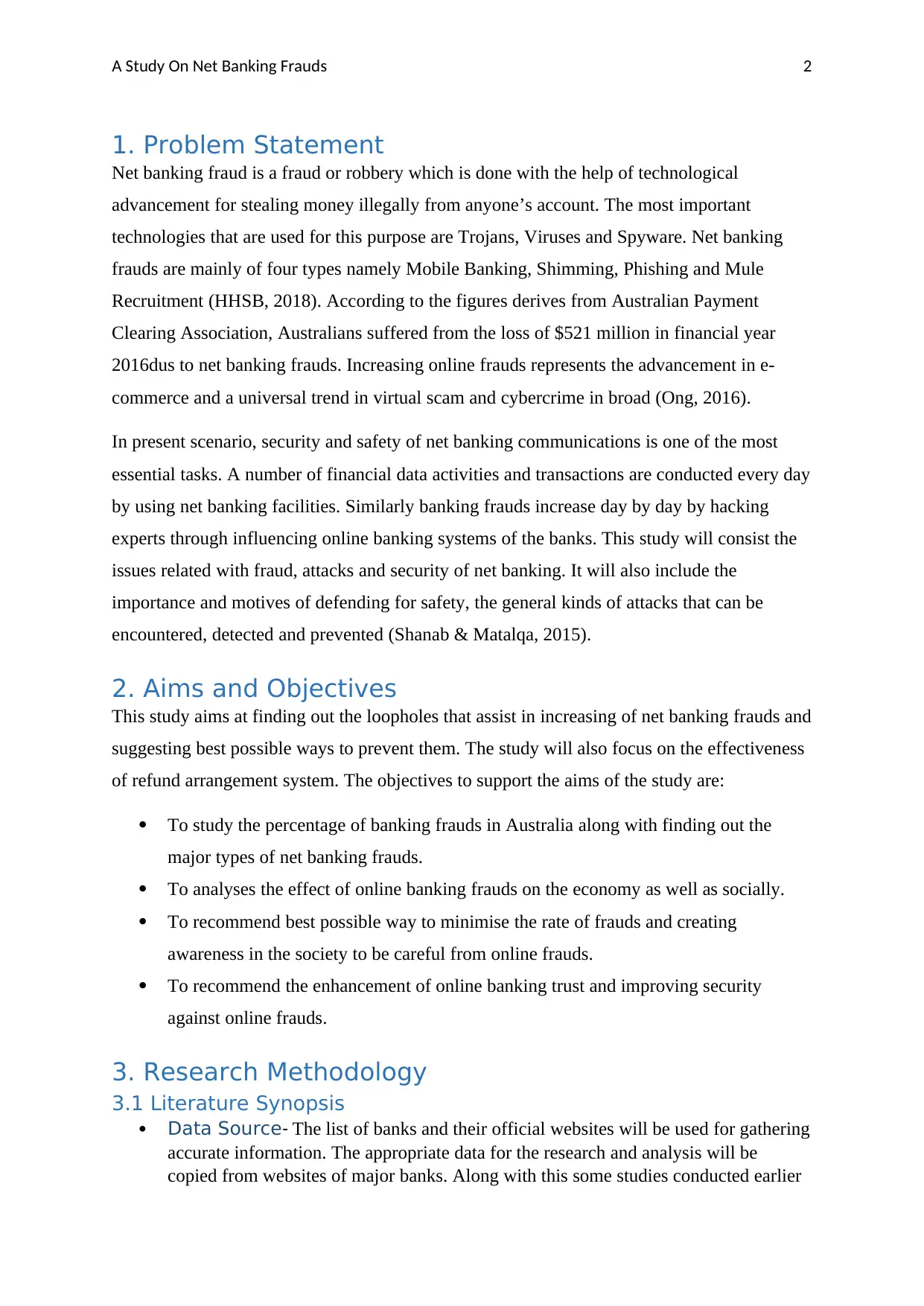
A Study On Net Banking Frauds 2
1. Problem Statement
Net banking fraud is a fraud or robbery which is done with the help of technological
advancement for stealing money illegally from anyone’s account. The most important
technologies that are used for this purpose are Trojans, Viruses and Spyware. Net banking
frauds are mainly of four types namely Mobile Banking, Shimming, Phishing and Mule
Recruitment (HHSB, 2018). According to the figures derives from Australian Payment
Clearing Association, Australians suffered from the loss of $521 million in financial year
2016dus to net banking frauds. Increasing online frauds represents the advancement in e-
commerce and a universal trend in virtual scam and cybercrime in broad (Ong, 2016).
In present scenario, security and safety of net banking communications is one of the most
essential tasks. A number of financial data activities and transactions are conducted every day
by using net banking facilities. Similarly banking frauds increase day by day by hacking
experts through influencing online banking systems of the banks. This study will consist the
issues related with fraud, attacks and security of net banking. It will also include the
importance and motives of defending for safety, the general kinds of attacks that can be
encountered, detected and prevented (Shanab & Matalqa, 2015).
2. Aims and Objectives
This study aims at finding out the loopholes that assist in increasing of net banking frauds and
suggesting best possible ways to prevent them. The study will also focus on the effectiveness
of refund arrangement system. The objectives to support the aims of the study are:
To study the percentage of banking frauds in Australia along with finding out the
major types of net banking frauds.
To analyses the effect of online banking frauds on the economy as well as socially.
To recommend best possible way to minimise the rate of frauds and creating
awareness in the society to be careful from online frauds.
To recommend the enhancement of online banking trust and improving security
against online frauds.
3. Research Methodology
3.1 Literature Synopsis
Data Source- The list of banks and their official websites will be used for gathering
accurate information. The appropriate data for the research and analysis will be
copied from websites of major banks. Along with this some studies conducted earlier
1. Problem Statement
Net banking fraud is a fraud or robbery which is done with the help of technological
advancement for stealing money illegally from anyone’s account. The most important
technologies that are used for this purpose are Trojans, Viruses and Spyware. Net banking
frauds are mainly of four types namely Mobile Banking, Shimming, Phishing and Mule
Recruitment (HHSB, 2018). According to the figures derives from Australian Payment
Clearing Association, Australians suffered from the loss of $521 million in financial year
2016dus to net banking frauds. Increasing online frauds represents the advancement in e-
commerce and a universal trend in virtual scam and cybercrime in broad (Ong, 2016).
In present scenario, security and safety of net banking communications is one of the most
essential tasks. A number of financial data activities and transactions are conducted every day
by using net banking facilities. Similarly banking frauds increase day by day by hacking
experts through influencing online banking systems of the banks. This study will consist the
issues related with fraud, attacks and security of net banking. It will also include the
importance and motives of defending for safety, the general kinds of attacks that can be
encountered, detected and prevented (Shanab & Matalqa, 2015).
2. Aims and Objectives
This study aims at finding out the loopholes that assist in increasing of net banking frauds and
suggesting best possible ways to prevent them. The study will also focus on the effectiveness
of refund arrangement system. The objectives to support the aims of the study are:
To study the percentage of banking frauds in Australia along with finding out the
major types of net banking frauds.
To analyses the effect of online banking frauds on the economy as well as socially.
To recommend best possible way to minimise the rate of frauds and creating
awareness in the society to be careful from online frauds.
To recommend the enhancement of online banking trust and improving security
against online frauds.
3. Research Methodology
3.1 Literature Synopsis
Data Source- The list of banks and their official websites will be used for gathering
accurate information. The appropriate data for the research and analysis will be
copied from websites of major banks. Along with this some studies conducted earlier
⊘ This is a preview!⊘
Do you want full access?
Subscribe today to unlock all pages.

Trusted by 1+ million students worldwide
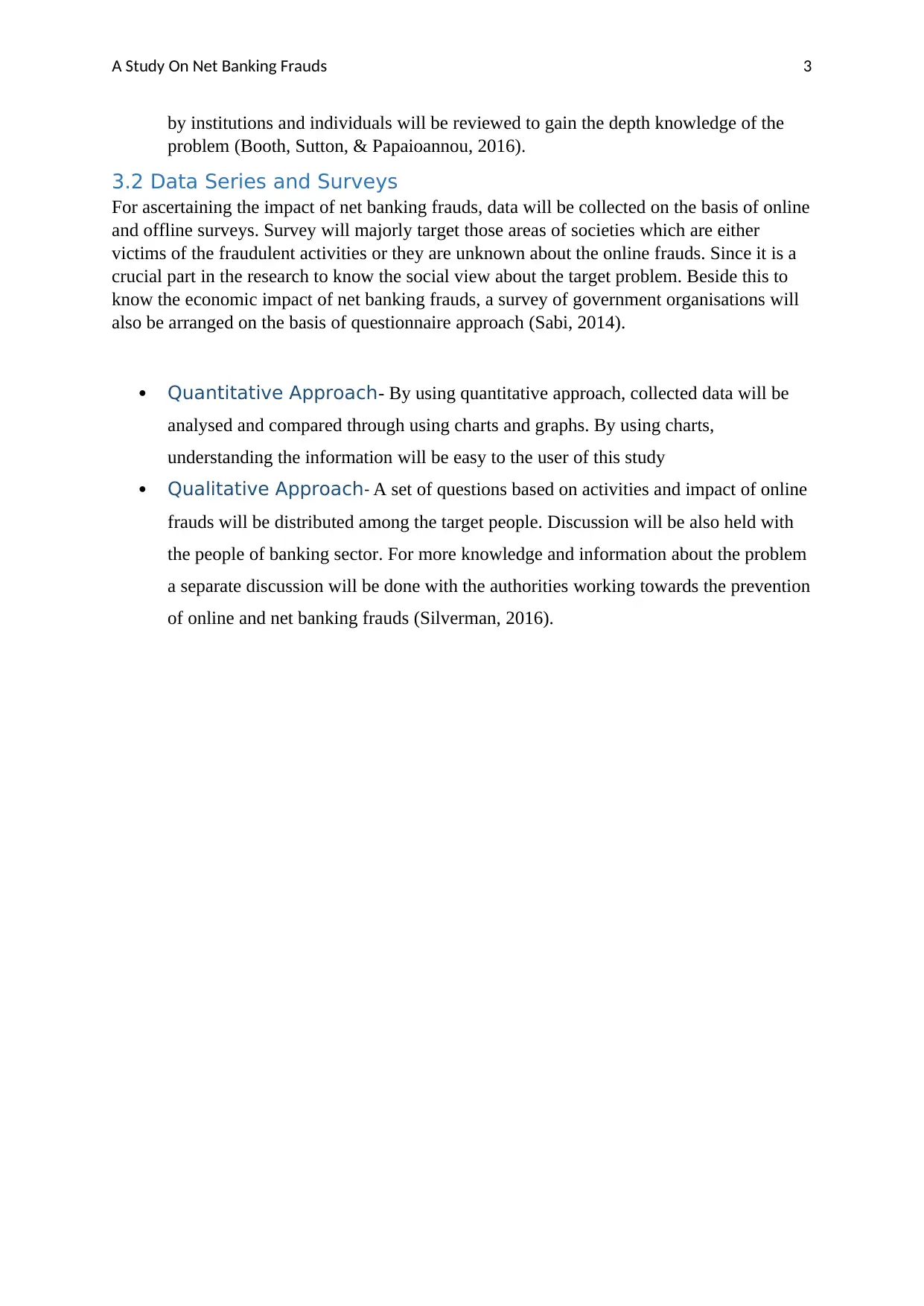
A Study On Net Banking Frauds 3
by institutions and individuals will be reviewed to gain the depth knowledge of the
problem (Booth, Sutton, & Papaioannou, 2016).
3.2 Data Series and Surveys
For ascertaining the impact of net banking frauds, data will be collected on the basis of online
and offline surveys. Survey will majorly target those areas of societies which are either
victims of the fraudulent activities or they are unknown about the online frauds. Since it is a
crucial part in the research to know the social view about the target problem. Beside this to
know the economic impact of net banking frauds, a survey of government organisations will
also be arranged on the basis of questionnaire approach (Sabi, 2014).
Quantitative Approach- By using quantitative approach, collected data will be
analysed and compared through using charts and graphs. By using charts,
understanding the information will be easy to the user of this study
Qualitative Approach- A set of questions based on activities and impact of online
frauds will be distributed among the target people. Discussion will be also held with
the people of banking sector. For more knowledge and information about the problem
a separate discussion will be done with the authorities working towards the prevention
of online and net banking frauds (Silverman, 2016).
by institutions and individuals will be reviewed to gain the depth knowledge of the
problem (Booth, Sutton, & Papaioannou, 2016).
3.2 Data Series and Surveys
For ascertaining the impact of net banking frauds, data will be collected on the basis of online
and offline surveys. Survey will majorly target those areas of societies which are either
victims of the fraudulent activities or they are unknown about the online frauds. Since it is a
crucial part in the research to know the social view about the target problem. Beside this to
know the economic impact of net banking frauds, a survey of government organisations will
also be arranged on the basis of questionnaire approach (Sabi, 2014).
Quantitative Approach- By using quantitative approach, collected data will be
analysed and compared through using charts and graphs. By using charts,
understanding the information will be easy to the user of this study
Qualitative Approach- A set of questions based on activities and impact of online
frauds will be distributed among the target people. Discussion will be also held with
the people of banking sector. For more knowledge and information about the problem
a separate discussion will be done with the authorities working towards the prevention
of online and net banking frauds (Silverman, 2016).
Paraphrase This Document
Need a fresh take? Get an instant paraphrase of this document with our AI Paraphraser
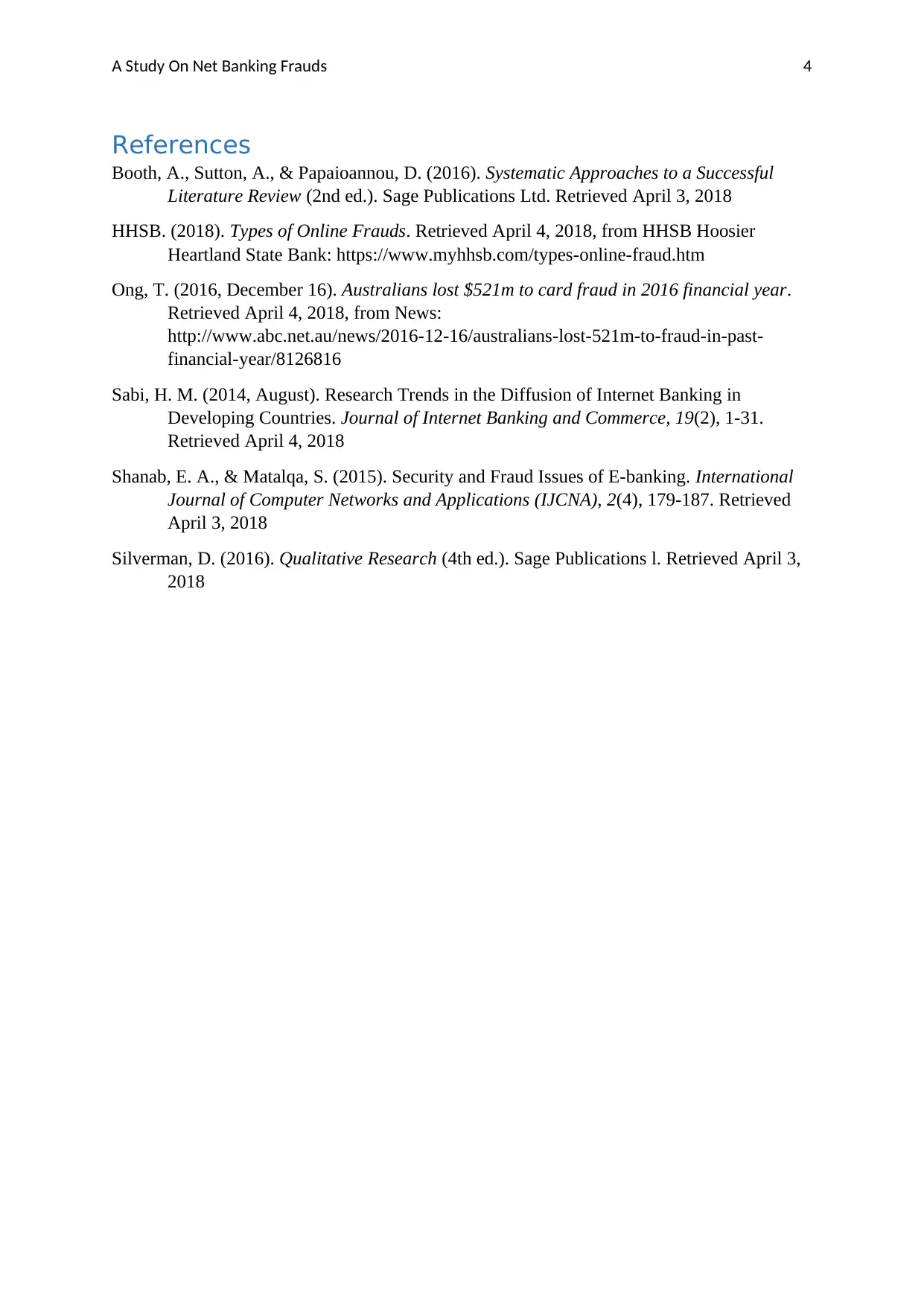
A Study On Net Banking Frauds 4
References
Booth, A., Sutton, A., & Papaioannou, D. (2016). Systematic Approaches to a Successful
Literature Review (2nd ed.). Sage Publications Ltd. Retrieved April 3, 2018
HHSB. (2018). Types of Online Frauds. Retrieved April 4, 2018, from HHSB Hoosier
Heartland State Bank: https://www.myhhsb.com/types-online-fraud.htm
Ong, T. (2016, December 16). Australians lost $521m to card fraud in 2016 financial year.
Retrieved April 4, 2018, from News:
http://www.abc.net.au/news/2016-12-16/australians-lost-521m-to-fraud-in-past-
financial-year/8126816
Sabi, H. M. (2014, August). Research Trends in the Diffusion of Internet Banking in
Developing Countries. Journal of Internet Banking and Commerce, 19(2), 1-31.
Retrieved April 4, 2018
Shanab, E. A., & Matalqa, S. (2015). Security and Fraud Issues of E-banking. International
Journal of Computer Networks and Applications (IJCNA), 2(4), 179-187. Retrieved
April 3, 2018
Silverman, D. (2016). Qualitative Research (4th ed.). Sage Publications l. Retrieved April 3,
2018
References
Booth, A., Sutton, A., & Papaioannou, D. (2016). Systematic Approaches to a Successful
Literature Review (2nd ed.). Sage Publications Ltd. Retrieved April 3, 2018
HHSB. (2018). Types of Online Frauds. Retrieved April 4, 2018, from HHSB Hoosier
Heartland State Bank: https://www.myhhsb.com/types-online-fraud.htm
Ong, T. (2016, December 16). Australians lost $521m to card fraud in 2016 financial year.
Retrieved April 4, 2018, from News:
http://www.abc.net.au/news/2016-12-16/australians-lost-521m-to-fraud-in-past-
financial-year/8126816
Sabi, H. M. (2014, August). Research Trends in the Diffusion of Internet Banking in
Developing Countries. Journal of Internet Banking and Commerce, 19(2), 1-31.
Retrieved April 4, 2018
Shanab, E. A., & Matalqa, S. (2015). Security and Fraud Issues of E-banking. International
Journal of Computer Networks and Applications (IJCNA), 2(4), 179-187. Retrieved
April 3, 2018
Silverman, D. (2016). Qualitative Research (4th ed.). Sage Publications l. Retrieved April 3,
2018

A Study On Net Banking Frauds 5
⊘ This is a preview!⊘
Do you want full access?
Subscribe today to unlock all pages.

Trusted by 1+ million students worldwide
1 out of 6
Related Documents
Your All-in-One AI-Powered Toolkit for Academic Success.
+13062052269
info@desklib.com
Available 24*7 on WhatsApp / Email
![[object Object]](/_next/static/media/star-bottom.7253800d.svg)
Unlock your academic potential
Copyright © 2020–2025 A2Z Services. All Rights Reserved. Developed and managed by ZUCOL.





